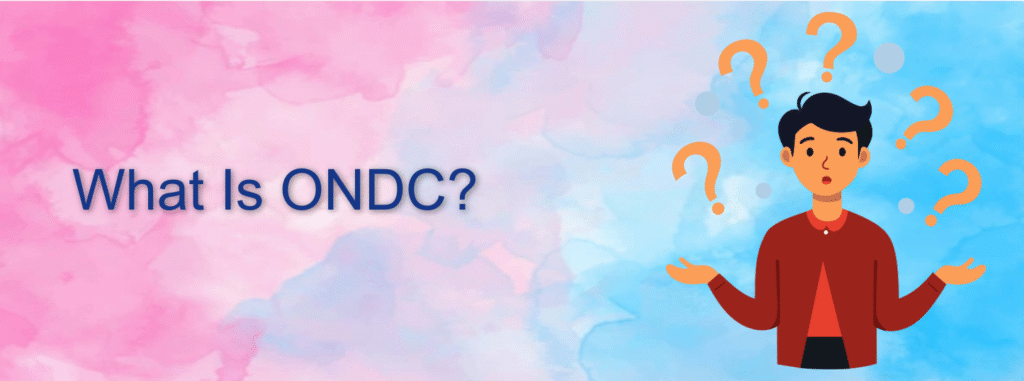What Is ONDC ?

India’s e-commerce landscape has long been dominated by a few giants—Amazon, Flipkart, and a handful of others. But this centralization has raised questions about monopoly, fair competition, and inclusivity for small and medium businesses.
To tackle these issues, India launched a groundbreaking initiative—ONDC (Open Network for Digital Commerce).
But what exactly is ONDC? And why is it being hailed as India’s answer to Amazon and Flipkart?
In this article, we decode the ONDC framework, its objectives, benefits, challenges, and its potential to transform Indian commerce forever.
🌐 What Is ONDC?
ONDC (Open Network for Digital Commerce) is a government-backed initiative by the Department for Promotion of Industry and Internal Trade (DPIIT) under the Ministry of Commerce and Industry.
Instead of a centralized marketplace (like Amazon or Flipkart), It is an open network where buyers and sellers can transact directly across any platform, app, or website—without being locked into a specific ecosystem.
Think of ONDC as the UPI for e-commerce: it creates a standard protocol that allows sellers and buyers to interact interoperably, regardless of the platform they use.
🧱 Key Features of ONDC
- Open-Source Protocol – Like HTTP for websites or UPI for payments
- Platform-Neutral – Seller and buyer apps can connect independently
- Interoperability – Any buyer can purchase from any seller across platforms
- Inclusive – Allows MSMEs, Kirana stores, startups, and local brands to join
- Decentralized – No single company owns or controls the network
🧾 How ONDC Works
Traditional E-Commerce:
- Seller must list products on Amazon/Flipkart
- Buyer must buy from the same app
- Platform controls listing, visibility, logistics, pricing, etc.
ONDC Model:
- Sellers register via any seller-side app (e.g., Mystore, SellerApp)
- Buyers can use any buyer-side app (e.g., Paytm, PhonePe, Meesho)
- Transactions happen across platforms using a common standard
- Logistics and payment providers also operate independently within the network
This opens the door for millions of small merchants to participate without being at the mercy of e-commerce giants.
💼 Who Benefits from ONDC?
1. MSMEs and Kirana Stores
- Can sell digitally without paying high commissions or advertising costs
- Retain control over pricing and product listings
2. Consumers
- Greater choice across platforms
- Potentially lower prices due to healthy competition
- Better service and transparency
3. Startups
- Can build buyer or seller apps, logistics solutions, or analytics services within the ONDC ecosystem
4. Government and Regulators
- Encourages digital adoption, reduces monopolies, and boosts economic inclusion
📊 Market Potential and Impact
- India’s e-commerce market is expected to reach $200 billion by 2027
- Currently, only ~6% of retail is online
- ONDC aims to digitize 30 million sellers and expand access to 900 million buyers
By opening up the digital marketplace, ONDC has the potential to:
- Democratize digital commerce
- Promote hyper-local ecosystems
- Drive job creation in logistics, tech, and retail
🏪 ONDC in Action: Real-World Examples
1. Local Grocery Stores (Kirana)
- A kirana store in Lucknow lists items via a seller app (e.g., Mystore)
- A buyer in the same area orders groceries via Paytm
- The delivery is handled by Dunzo, and payment is routed via UPI
- All parties are part of ONDC, but not owned by one company
2. Restaurants and Food Delivery
- Small restaurants list menus on seller apps
- Buyer places order using -integrated platforms like Magicpin
- Delivery by third-party -compliant logistics partners
- Lower fees than Swiggy/Zomato for both restaurants and users
📌 Major Partners and Stakeholders
Key Buyer Apps:
- Paytm
- PhonePe (Pincode)
- Craftsvilla
- Magicpin
- Snapdeal
Key Seller Apps:
- Mystore
- eSamudaay
- SellerApp
- Digiit
Logistics and Payments:
- Loadshare, Dunzo, Delhivery
- NPCI (UPI, RuPay integration)
Banks and Financial Supporters:
- SBI, Kotak Mahindra, HDFC Bank
- SIDBI, NABARD
📈 Growth and Adoption Status (as of 2025)
- Over 1.5 lakh sellers onboarded
- Daily transactions in food, groceries, fashion, and electronics
- Active in 180+ cities and towns
- Merchant adoption highest in Bangalore, Delhi, Lucknow, and Bhopal
🔍 How ONDC Is Different from Amazon/Flipkart
| Feature | Amazon/Flipkart | ONDC |
|---|---|---|
| Ownership | Private Corporation | Government-backed open network |
| Commission Fees | 20–35% | Low to zero |
| Control Over Search | Centralized algorithm | Buyer-side app controls results |
| Seller Autonomy | Limited | High |
| Entry Barrier for MSMEs | High | Low |
| Interoperability | No | Yes |
🧠 Challenges Facing ONDC
- User Awareness – Most consumers are unaware of ONDC
- Merchant Onboarding – Tech-shy MSMEs need training and support
- Logistics Coordination – Seamless integration across different delivery partners
- Consumer Trust – Amazon/Flipkart have built strong brand loyalty
- UX Consistency – Different apps = inconsistent user experience
However, with continued government push and stakeholder commitment, these can be gradually addressed.
🔮 What’s Next for ONDC?
- Expansion to Tier 3–4 cities and rural markets
- International shipping modules for Indian sellers
- Credit and insurance products for merchants
- Voice-based commerce in regional languages
- Integration with India Stack—Aadhaar, UPI, Account Aggregator
🧠 Final Thoughts
ONDC represents a bold, ambitious move by India to democratize digital commerce—breaking down the walled gardens created by e-commerce monopolies.
If successful, It will not only give millions of small sellers a digital voice, but also redefine how Indians shop, sell, and scale online.
Just as UPI made India a global model for payments, ONDC could make India the pioneer of open digital marketplaces.
USEFUL LINKS:
https://en.wikipedia.org/wiki/Open_Network_for_Digital_Commerce?utm_source=chatgpt.com
https://www.ibm.com/think/topics/ondc?utm_source=chatgpt.com

